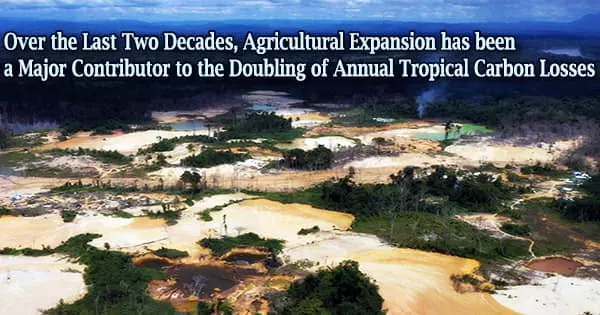Agricultural land, which includes croplands, pastures, orchards, groves, vineyards, nurseries, decorative horticultural areas, confined feeding operations, and other agricultural applications, can be defined generically as land utilized primarily for the production of food and fiber.
With an estimated population of 10 to 11 billion humans on Earth by the end of this century, agricultural expansion is frequently explained as a direct result of global increases in food and energy requirements due to continued population growth (both of which have been attributed to the agricultural expansion itself).
Researchers from the Department of Civil Engineering at the University of Hong Kong (HKU) and the Southern University of Science and Technology (SUSTech) discovered that tropical carbon loss has doubled in the last two decades due to excessive forest removal in the tropics, using multiple high-resolution satellite datasets.
The tropics are an essential ecosystem because they store large amounts of carbon in their woody vegetation and soil, but since 2001, they have been subjected to considerable forest removal.
During the twenty-first century, the researchers looked at the gross forest carbon loss related with forest removal in the tropics (between 23.5° N and 23.5° S, but excluding northern Australia).
Due to fast forest loss, they discovered a two-fold increase in gross tropical forest carbon loss from 0.97 gigatons of carbon per year in 2001-2005 to 1.99 gigatons of carbon per year in 2015-2019.
“Doubling of yearly forest carbon loss throughout the tropics during the early twenty-first century,” according to the study, which was published in the academic journal Nature Sustainability. Given the importance of the tropics in the carbon cycle, the findings are significant.
The doubling and acceleration in the loss of forest carbon, including biomass and soil organic carbon, is primarily driven by agricultural expansion which differs from current estimates of land-use change emissions in the assessments of the global carbon budget that shows a flat or decreasing trend. In addition to carbon, conversion of forests to agricultural lands also induces other environmental consequences, like biodiversity extinction and land degradation.
Yu FENG
“The findings are critical because they suggest that existing strategies to reduce forest loss are questionable; this failure underscores the importance of monitoring deforestation trends following one of the new pledges made to halt and reverse deforestation by UN climate summit-the twenty-sixth Conference of the Parties (COP26) in Glasgow in November 2021,” said Professor Ji CHEN from HKU’s Department of Civil Engineering.
Tropical forests store over 250 gigatons of biomass carbon in their woody plants and absorb about 70 gigatons of atmospheric carbon every year through photosynthesis, making them the greatest terrestrial component of the global carbon cycle.
The loss of forests at a rapid and consistent rate could be disastrous since it results in the loss of carbon stored in biomass and soil. Deforestation also hampered carbon sequestration or the act of absorbing and holding carbon dioxide.
“The doubling and acceleration in the loss of forest carbon, including biomass and soil organic carbon, is primarily driven by agricultural expansion which differs from current estimates of land-use change emissions in the assessments of the global carbon budget that shows a flat or decreasing trend. In addition to carbon, conversion of forests to agricultural lands also induces other environmental consequences, like biodiversity extinction and land degradation,” said Yu FENG, a Ph.D. candidate of the HKU and SUSTech joint program.
Agricultural expansion, such as shifting cultivation, was responsible for the majority of tropical forest carbon loss (82 percent), mainly in Africa.
“While some agricultural lands may reappear as forested due to abandonment or policies, we still observed about 70% of former forest lands converted to agriculture in 2001-2019 remained so in 2020, confirming a dominant role of agriculture in long-term pan-tropical carbon reductions on formerly forested landscapes,” said research team member Dr. Zhenzhong Zeng, Associate Professor at SUSTech.
“The 2014 New York Declaration on Forests promised to halve tropical deforestation by 2020. However, our results demonstrate a failure to the commitment and highlight the colossal challenge posed by the 2021 Glasgow Leaders’ Declaration on Forests and Land Use, which pledges to halt forest loss by 2030,” said Dr. Chunmiao Zheng, Chair Professor at SUSTech and a member of the research team.
















